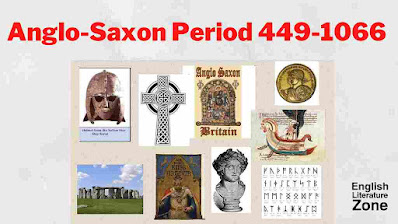Exploring the Anglo-Saxon Period: A Journey Through Early English Literature(449-1066)
Characteristics of the Anglo-Saxon period in literature
The term "Anglo-Saxon" refers to the early medieval period of English history, roughly spanning from the 5th to the 11th century. It encompasses the time after the departure of the Roman legions from Britain around 410 AD to the Norman Conquest of England in 1066 AD. The term is also used to describe the people, language, and culture of this era.
1. People:
The Anglo-Saxons were Germanic tribes who migrated to Britain from regions corresponding to modern-day Germany and Denmark. The three primary groups were the Angles, Saxons, and Jutes. These tribes settled in various parts of Britain and gradually established several kingdoms, such as Wessex, Mercia, Northumbria, and East Anglia.
2. Language:
The language spoken by the Anglo-Saxons is known as Old English. It is a Germanic language closely related to Old Frisian, Old Saxon, and Old Norse. Old English evolved from the languages brought by the Anglo-Saxon settlers and underwent significant changes over time. Modern English speakers would find Old English largely incomprehensible without study, though some words and phrases have survived into modern English.
3. Culture:
Anglo-Saxon society was organized into hierarchical structures. At the top were kings and nobles, followed by warriors, freemen, and slaves or serfs at the bottom. Society was predominantly agrarian, with farming as the primary occupation. Religion played a significant role, initially with pagan beliefs and later with the conversion to Christianity, which began in the 6th century and was largely completed by the 8th century.
4. Literature and Art:
The Anglo-Saxons produced a rich body of literature, primarily in the form of poetry, including epic poems like "Beowulf" and religious works like "The Dream of the Rood." They also created intricate metalwork, jewelry, and illuminated manuscripts, exemplified by artifacts like the Sutton Hoo treasure and the Lindisfarne Gospels.
5. History:
The Anglo-Saxon period was marked by various historical events, including invasions by other Germanic tribes, conflicts with indigenous Britons and later with Viking invaders, and the eventual unification of England under one ruler, King Æthelstan, in the 10th century. The period ended with the Norman Conquest of England in 1066, which brought about significant changes in governance, culture, and language.
Characteristics:
1. Oral Tradition:
One of the most prominent features of Anglo-Saxon literature is its strong oral tradition. Before the widespread use of writing, stories, legends, and historical accounts were passed down orally from generation to generation. This tradition is evident in epic poems like "Beowulf," which were composed to be recited or sung aloud in mead halls and other communal settings.
2. Heroic Ethos:
Anglo-Saxon literature often celebrates heroic deeds, valor, and prowess in battle. The hero, typically a warrior or king, embodies virtues such as courage, loyalty, and honor. In "Beowulf," the eponymous hero's exploits against monstrous foes exemplify this heroic ethos, serving as a model for Anglo-Saxon ideals of heroism.
3. Fate and Destiny:
Central to Anglo-Saxon literature is the belief in wyrd, or fate, which governs the lives of individuals and determines their destinies. Characters in Anglo-Saxon works often confront the inexorable workings of fate, accepting their predetermined fates with stoicism and fatalism. This theme is particularly prominent in "Beowulf," where the hero's ultimate fate is foretold from the outset.
4. Pagan and Christian Influences:
The Anglo-Saxon period witnessed a transition from paganism to Christianity, and this duality is reflected in its literature. While many works contain remnants of pagan beliefs and motifs, such as references to Germanic gods and supernatural creatures, Christian themes and values also permeate the literature, especially in religious texts like "The Dream of the Rood" and "Caedmon's Hymn."
5. Alliteration and Kennings:
Anglo-Saxon poetry is characterized by its use of alliteration and kennings. Alliteration, the repetition of initial consonant sounds, lends rhythm and musicality to the verse, while kennings are metaphorical expressions used in place of simple nouns, adding richness and complexity to the language. These poetic devices are evident throughout Anglo-Saxon poetry, contributing to its distinctive style and cadence.
6. Didactic and Moralizing Elements:
Much Anglo-Saxon literature serves didactic and moralizing purposes, imparting lessons on proper behavior, loyalty to kin and lord, and the consequences of hubris and greed. Moral injunctions and ethical dilemmas are woven into the narrative fabric of works like "Beowulf" and the Anglo-Saxon Chronicle, reflecting the cultural and ethical concerns of the time.
7. Historical and Legendary Content:
Anglo-Saxon literature encompasses both historical and legendary material, blurring the lines between fact and fiction. Historical events, such as battles, royal genealogies, and the deeds of kings, are chronicled alongside mythical tales of dragons, giants, and other fantastical beings. This blending of history and legend contributes to the rich tapestry of Anglo-Saxon literature, capturing the imaginations of readers across the centuries.






Comments
Post a Comment